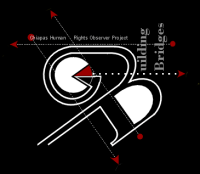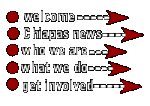

The Building Bridges in Chiapas Human Rights Observer Project
The Communities That "Don't Exist"
Observer Reports from Olga Isabel and Polho San Pedro by Stefan Schmitt

Olga Isabel is an autonomous Zapatista community located about 45 minutes drive from the city of Ocosingo. The land was previously owned by ranchers who used the land for commercial agriculture. Olga Isabel formed in 1994 when Zapatista rebels reclaimed this land. The land title is still held by ranchers.
Although no official attempt has been made to evict the community paramilitary violence is an unfortunate feature in the lives of Olga Isabel residents. One recent incident received international attention. According to an article in the publication Reforma reprinted on the Mexican Solidarity Network web site and a statement issued by the EZLN community and Zapatista leader Antonio Mejia was murdered August 26, 2002 in the nearby community of K'an Akil. Ample evidence implicates the paramilitary group Los Aquilares (The Eagles) as responcible for this execution.
Olga Isabel was also the site of a road blockade maintained by the Zapatistas as protest against road building. Road construction is considered to be a repressive tactic of the military.
It was apparent to me that the people of Olga Isabel were suffering much stress due to the war waged against them. Stress was evident in the faces and expressions of these people. Also I witnessed several meetings taking place in the community. Although I could not comprehend the indigenous language (Tzeltal) the atmosphere conveyed that the subject of these gatherings was of dire content. People often seemed quite upset.
More tangible evidence of conflict in the region came from interaction with outside, non-Zapatista community members. Upon arriving by truck we were unsure if the community we had stopped in front of was Olga Isabel. When asked the driver stated that no such community existed. Our responsabla told us that this was typical of the pristers (PRI party supporters). They refuse to acknowledge the existence of the autonomous Zapatista community.
Another incident occurred in interaction with residents of the neighboring "prister" community. A pick up truck with two men pulled up beside me when I was standing roadside. Both men were drinking beer and were rather drunk. In conversation they questioned me as to my country of origin and presence in Ogla Isabel. I was honest about being a peace observer. On this matter They were quite belligerent, mocking me for my efforts. As our conversation ended they yelled at me, and laughed while tearing off in their truck.
The community members of Olga Isabel were extremely generous with gratitude. While walking around the community I met many people. Always I was greeted with smiles, and given much thanks for my presence. As well, the people were very generous. It was arranged that every morning two different families would provide tortillas for our food supply. We received such large quantities of tortillas each day that it was more than we could do to eat the lot. We were also given a large bag of coffee and a huge bag of beans. I took the obvious over abundance of food to be a gesture of thanks from the people. Of course, implicit in their gratitude for our presence as peace observers lurked the aforementioned political tension and threat of violence imposed upon the community.


Left: Corn growing at Olga Isabel and Right: Shade grown coffee
The community draws it sustenance from agriculture. Interspersed throughout the jungle are large patches of Milpa (corn field). Also farmed are beans, bananas, chickens, and coffee. The coffee plantations consisted of huge tracks of jungle with the coffee plants growing in the shade, under the trees. I was very impressed with this and noted the large diversity of jungle plants present. My impression was that the integrity the jungle ecology was maintained while at the same time the land was utilized to raise this important crop. coffee is produced as a cash crop. While in San Cristobal I noticed the sale of Zapatista coffee in several stores


Left: Teacher with the kids inside the school house and Right: Outside the school house
The children of the community attend a one classroom school. The school is run by one volunteer community member who has taken it upon himself to educate the kids. We were invited to attend the school session one afternoon.


Left: Sunset and Right: Clay Oven and banana plants
I really enjoyed my stay at Olga Isabel. The community went out of its way to make us feel welcome. As well I really felt like my presence as a human rights observer made a positive contribution to this community.
Human rights observation report for Polho, March 11 to April 3, 2003

The autonomous community of Polho San Pedro was formed in 1997 when paramilitary activity in the area forced people to flea from their villages. Polho is a refugee camp. Today it consists of some 8000 such "desplazados."
Polho is situated at 1.5 hours drive from San Cristobal, and 10 minutes before the now famous community of Acteal, the site of a para military massacre in 1998. Infact many of the refugees were driven from their homes by the paramilitary violence leading up to the Acteal massacre.
Government and military used the violence at Acteal as reason to establish yet another military base in Chiapas. This one is right next to Acteal, close to Polho.


Left: Over looking a basket ball court at Polho and Right: Corn growing at Polho
The terrain is mountainous. The corn fields (milpa) often appear to clinging to the steep slopes around the community. Due to the mountainous geography and the huge population it is not possible for Polho to grow enough food to feed the community. Coffee production does provide some income however. While I was there I often saw the beans laid out to dry on the basket ball court. It seemed that this was done on the days leading up to the full moon. On the night of the full moon their was one special sack of coffee beans laid out on the court to be exposed to the light of the moon itself. I guessed that this was an aspect of Mayan culture. A calendar based on lunar cycle figures of much importance in agricultural practice of Mayan people all over the Mayan Americas.
Polho relies heavily on food donation and other aid for survival. Their are many organizations that donate such aid. While in San Cristobal, before I left for Polho, I met a group from the United States called "Pastors for Peace." According to one of their members they had donated some 17 tons of food aid to Polho. Apparently though, this quantity of food was only expected to last for only a couple of weeks! I was given the impression by Pastors for Peace that Polho is basically surviving week to week, wondering where the next donation of supplies will come from.
Apart from food and medicine international aid has contributed educational materials for the school, a green house, and also while I was there, many foreigners were helping to develop and maintain the physical infrastructure of the community. For example some people with plumbing skills were installing pipes to a nearby water spring in the mountains.
The Zapatistas have built here; a school, a municipal hall, and a medical clinic (The Mexican Red Cross also maintains a clinic here). I am very impressed by how organized and strong this community is. Despite having lost their homes and farmland the community has managed to arrange all the basic needs of life for all 8000+ refugees. This is done of course without any assistance from the Mexican government.
Human rights observers are given a dormitory room to sleep in. Their was a kitchen for us to use in another building but at the time I was there the gas stove was broken. Because of this we were invited to eat in the community kitchen. This kitchen always had a supply of tortillas and beans. In the day time their were several women preparing these items. I'm not entirely sure who in the community was given right to this food. It seemed mainly for the people who ran the school and others of associated with important infrastructure of Polho.


Left: smoke in the kitchen and Right: tortillas grilling on the fire
One feature of the kitchen which really struck me was the lack of chimney. There were some holes in the cinder block wall to let smoke escape. But generally the place was thick with smoke from the fire. Ones eyes would burn from it, as well, often people were coughing. The walls and windows were totally blackened with soot. I wonder if this lack of chimney, and smoke problem is a consequence of sudden technology change. Traditionally buildings were constructed from wooden boards with some cracks in between the boards. Roofs were made of thatch. Thus there was more ventilation and smoke could work its way through the roof. Personally, I think that a chimney would be a good addition to modern Mayan building technique.
On the side of the building that was our dormitory were a couple of wooden pens. At first I thought these were to keep animals, goats maybe. However, they turned out to be the local lock up, jail that is. One day a couple of men were locked up in one. We didn't ask why but suspected it may have been for drinking. The Zapatista have rather strict rules for this vice. First two times; the drinker gets a couple days in the slammer, the next time they get banished from the community!.
I wondered if the jail conditions were a little harsh. The prisoners had their arms tied to the wall. This may have impeded them from lying down to sleep. Also I didn't see any sort of bucket or toilet in the cell. I didn't look into their situation too much as I didn't want to seem like I was gawking at their unfortunate circumstances. But I did raise the question of prison conditions with Enlace Civil: I suggested investigating.
The duties of human rights observers in Polho included sitting in the gate house beside the road, noting the passage of military and police traffic on the road. There proved to be quite a volume of this traffic, probably due to the nearby millitary base. The military were usually transporting troops back and forth. This was usually done using Hummer jeeps, however, often larger trucks were used. Often the trucks would be equipped with machine gun turrets, and nearly always the soldiers were armed with machine guns.
My general impression of the place was that circumstances have forced these people to be alot tougher and stronger than life demands of people like myself. Their were a couple of days when the weather was quite miserable; rainy and cold. I wore all my warm clothes (fleece pants and top) and was still cold. However, I saw many people walking bare foot in the mud, as well as dressed in the flimest of garb. quite a few people were wearing only T-shirts, or the traditional cotton tunic worn by some of the men. The latter is a long sleeved shirt, open under the arms, with a short skirt attached.
The residents of Polho were very hospitable. They seemed glad that international observers were taking an interest in their struggle. Many times people stopped to chat with me. I enjoyed staying there for three weeks.
Click here to return to Building Bridges Getting Involved.